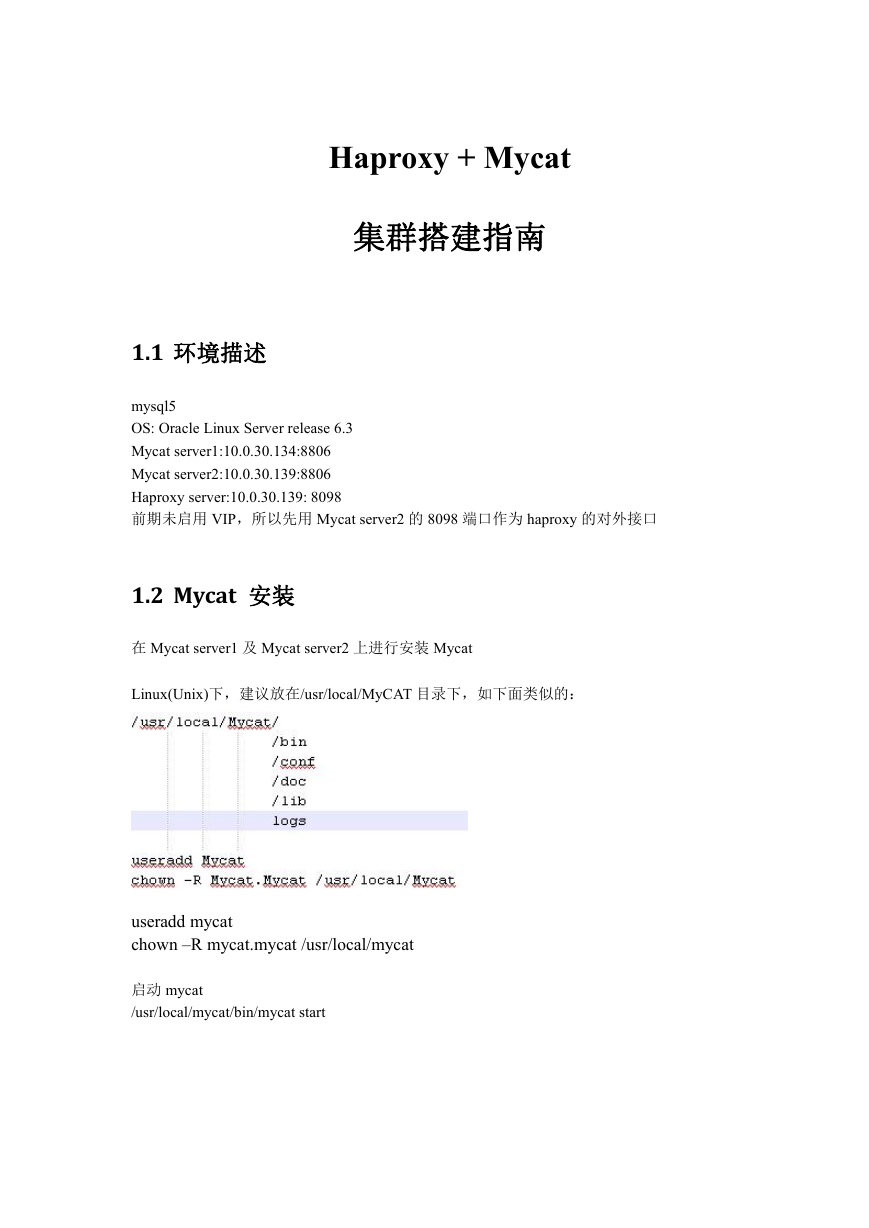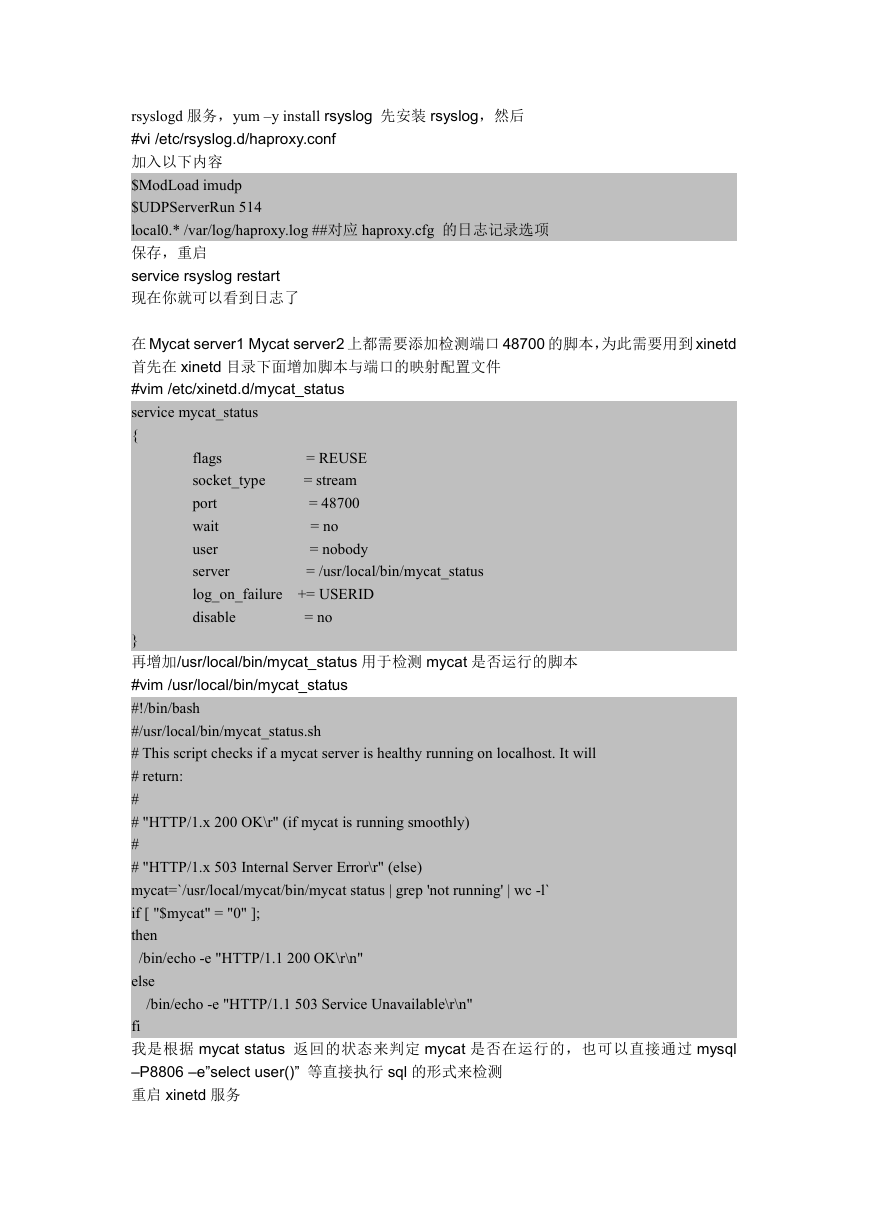Haproxy + Mycat
集群搭建指南
1.1 环境描述
mysql5
OS: Oracle Linux Server release 6.3
Mycat server1:10.0.30.134:8806
Mycat server2:10.0.30.139:8806
Haproxy server:10.0.30.139: 8098
前期未启用 VIP,所以先用 Mycat server2 的 8098 端口作为 haproxy 的对外接口
1.2 Mycat 安装
在 Mycat server1 及 Mycat server2 上进行安装 Mycat
Linux(Unix)下,建议放在/usr/local/MyCAT 目录下,如下面类似的:
useradd mycat
chown –R mycat.mycat /usr/local/mycat
启动 mycat
/usr/local/mycat/bin/mycat start
�
1.3 Haproxy 的安装
useradd haproxy
#wget http://haproxy.1wt.eu/download/1.4/src/haproxy-1.4.25.tar.gz
# tar zcvf haproxy-1.3.20.tar.gz
# cd haproxy-1.3.20
# make TARGET=linux26 PREFIX=/usr/local/haprpxy ARCH=x86_64
# make install
安装完毕后,进入安装目录创建配置文件
# cd /usr/local/haproxy
#chown –R haproxy.haproxy *
# vi haproxy.cfg
global
##记日志的功能
local0
log 127.0.0.1
maxconn 4096
chroot /usr/local/haproxy
user haproxy
group haproxy
daemon
defaults
dontlognull
3
log global
option
retries
option redispatch
maxconn 2000
contimeout
clitimeout
srvtimeout
5000
50000
50000
##由于没有启用 VIP,暂时用其中一台的 IP 和新端口
##统计页面
listen
admin_stats 10.0.30.139:48800
stats uri /admin-status
stats auth
mode
option
admin:admin
http
httplog
listen
allmycat 10.0.30.139:8098
mode tcp
option tcplog
option httpchk OPTIONS * HTTP/1.1\r\nHost:\ www
balance
server mycat_134 10.0.30.134:8066 check port 48700 inter 5s rise 2 fall 3
server mycat_139 10.0.30.139:8066 check port 48700 inter 5s rise 2 fall 3
srvtimeout 20000
roundrobin
默认 haproxy 是不记录日志的,为了记录日志还需要配置 syslog 模块,在 oracle linux 下是
�
rsyslogd 服务,yum –y install rsyslog 先安装 rsyslog,然后
#vi /etc/rsyslog.d/haproxy.conf
加入以下内容
$ModLoad imudp
$UDPServerRun 514
local0.* /var/log/haproxy.log ##对应 haproxy.cfg 的日志记录选项
保存,重启
service rsyslog restart
现在你就可以看到日志了
在 Mycat server1 Mycat server2 上都需要添加检测端口 48700 的脚本,为此需要用到 xinetd
首先在 xinetd 目录下面增加脚本与端口的映射配置文件
#vim /etc/xinetd.d/mycat_status
service mycat_status
{
= REUSE
= stream
= 48700
= no
= nobody
= /usr/local/bin/mycat_status
flags
socket_type
port
wait
user
server
log_on_failure += USERID
disable
= no
}
再增加/usr/local/bin/mycat_status 用于检测 mycat 是否运行的脚本
#vim /usr/local/bin/mycat_status
#!/bin/bash
#/usr/local/bin/mycat_status.sh
# This script checks if a mycat server is healthy running on localhost. It will
# return:
#
# "HTTP/1.x 200 OK\r" (if mycat is running smoothly)
#
# "HTTP/1.x 503 Internal Server Error\r" (else)
mycat=`/usr/local/mycat/bin/mycat status | grep 'not running' | wc -l`
if [ "$mycat" = "0" ];
then
/bin/echo -e "HTTP/1.1 200 OK\r\n"
else
/bin/echo -e "HTTP/1.1 503 Service Unavailable\r\n"
fi
我是根据 mycat status 返回的状态来判定 mycat 是否在运行的,也可以直接通过 mysql
–P8806 –e”select user()” 等直接执行 sql 的形式来检测
重启 xinetd 服务
�
#service xinetd restart
查看 48700 端口是否监听了
#netstat -antup|grep 48700
如上图则端口的配置正确了
启动 haproxy
/usr/local/haproxy/sbin/haproxy -f /usr/local/haproxy/haproxy.cfg
为了使用方便可以增加一个启动,停止 haproxy 的脚本
启动脚本 starthap 内容如下
#!/bin/sh
/usr/local/haproxy/sbin/haproxy -f /usr/local/haproxy/haproxy.cfg &
停止脚本 stophap 内容如下
#!/bin/sh
ps -ef | grep sbin/haproxy | grep -v grep |awk '{print $2}'|xargs kill -s 9
分别赋予启动权限
chmod +x starthap
chmod +x stophap
启动后可以通过 http://10.0.30.139:48800/admin-status (用户名密码都是 admin haproxy.cnfg 配
置的)
配置完成
�








 2023年江西萍乡中考道德与法治真题及答案.doc
2023年江西萍乡中考道德与法治真题及答案.doc 2012年重庆南川中考生物真题及答案.doc
2012年重庆南川中考生物真题及答案.doc 2013年江西师范大学地理学综合及文艺理论基础考研真题.doc
2013年江西师范大学地理学综合及文艺理论基础考研真题.doc 2020年四川甘孜小升初语文真题及答案I卷.doc
2020年四川甘孜小升初语文真题及答案I卷.doc 2020年注册岩土工程师专业基础考试真题及答案.doc
2020年注册岩土工程师专业基础考试真题及答案.doc 2023-2024学年福建省厦门市九年级上学期数学月考试题及答案.doc
2023-2024学年福建省厦门市九年级上学期数学月考试题及答案.doc 2021-2022学年辽宁省沈阳市大东区九年级上学期语文期末试题及答案.doc
2021-2022学年辽宁省沈阳市大东区九年级上学期语文期末试题及答案.doc 2022-2023学年北京东城区初三第一学期物理期末试卷及答案.doc
2022-2023学年北京东城区初三第一学期物理期末试卷及答案.doc 2018上半年江西教师资格初中地理学科知识与教学能力真题及答案.doc
2018上半年江西教师资格初中地理学科知识与教学能力真题及答案.doc 2012年河北国家公务员申论考试真题及答案-省级.doc
2012年河北国家公务员申论考试真题及答案-省级.doc 2020-2021学年江苏省扬州市江都区邵樊片九年级上学期数学第一次质量检测试题及答案.doc
2020-2021学年江苏省扬州市江都区邵樊片九年级上学期数学第一次质量检测试题及答案.doc 2022下半年黑龙江教师资格证中学综合素质真题及答案.doc
2022下半年黑龙江教师资格证中学综合素质真题及答案.doc